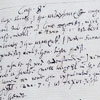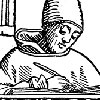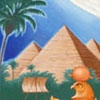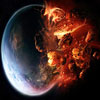Revision Of The Old Testament
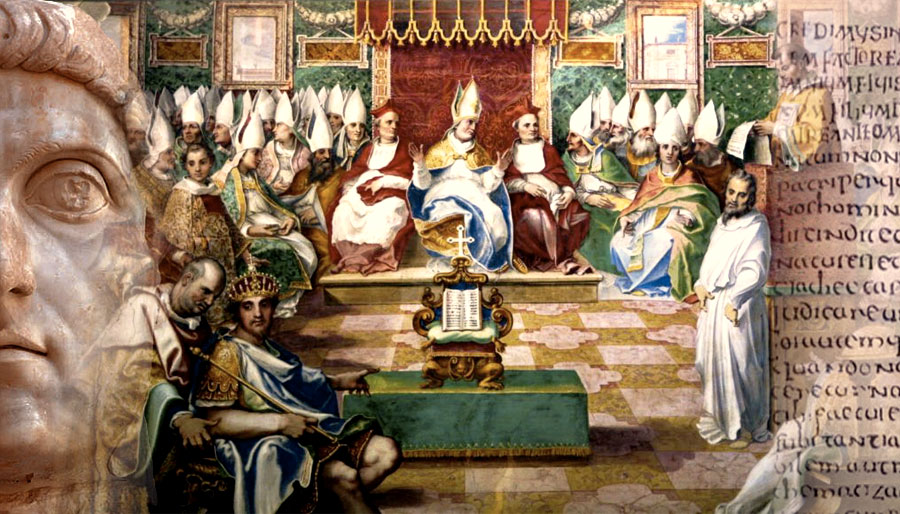 by Robert Charroux
by Robert Charroux
The commandments were dictated to Moses on Mount Sinai and the Law was written by God himself: “Moses turned and went down the mountain with the two tablets of the Tokens in his hands, inscribed on both sides; on the front and on the back they were inscribed. The tablets were the handiwork of God, and the writing was God’s writing, engraved on the tablets.” (Exodus 32: 15-16.)
It would seem inconceivable that believers would dare to contest and falsify what is most sacred and divine in the Law: God’s Commandments. And yet . . .
The Fifteen Commandments
God’s Commandments are stated in the twentieth chapter of Exodus (and also in the fifth chapter of Deuteronomy, with variations). In verses 4-6 we read: “You shall not make a carved image for yourself nor the likeness of anything in the heavens above, or on the earth below, or in the waters under the earth. You shall not bow down to them or worship them; for I, the Lord your God, am a jealous god. I punish the children for the sins of the fathers to the third and fourth generations of those who hate me. But I keep faith with thousands, with those who love me and keep my commandments.”
The text is perfectly clear and precise: it is forbidden to draw, paint, or carve images of God, angels, saints, Jesus, Mary, Gabriel, etc., or even of anything on or under the earth or in the sky. Crucifixes are undeniably sacrilegious, as are statues of the Holy Family and the Apostles, pious images inserted in missals, illustrated Bibles, and illustrated publications of all kinds. Newspaper publishers, for example, can be assured of a place in hell, along with television producers.
Bearing in mind that the Commandments are not numbered in the Bible, we can make the following list of fifteen, taken from the twentieth chapter of Exodus:
- “You shall have no other god to set against me.” (Verse 3.)
- “You shall not make a carved image for yourself not the likeness of anything in the heavens above, or on the earth below, or in the waters under the earth.” (Verse 4.)
- “You shall not bow down to them or worship them.” (Verse 5.)
- “You shall not make wrong use of the name of the Lord your God.” (Verse 7.)
- “Remember to keep the sabbath day holy.” (Verse 8.)
- “Honor your father and mother.” (Verse 12.)
- “You shall not commit murder.” (Verse 13.)
- “You shall not commit adultery.” (Verse 14.)
- “You shall not steal.” (Verse 15.)
- “You shall not give false evidence against your neighbor.” (Verse 16.)
- “You shall not covet your neighbor’s house; you shall not covet your neighbor’s wife, his slave, his slave-girl, his ox, his ass, or anything that belongs to him.” (Verse 17.)
- “You shall not make gods of silver to be worshiped as well as me, nor shall you make your self gods or gold.” (Verse 17.)
- “You shall make an altar of earth for me, and you shall sacrifice on it both your whole-offerings and your shared-offerings, your sheep, and your cattle.” (Verse 24.)
- “If you make an altar of stones for me, you must not build it of hewn stones, for if you use a chisel on it, you will profane it.” (Verse 25)
- “You must not mount up to my altar by steps, in case your private parts be exposed on it.” (Verse 26)
God’s Law is Flouted
It is appalling to realize that twelve of these fifteen commands are disobeyed by the Church, which truly respects only the first and the fourth. God himself is flouted, for it is not honoring him to disobey him, to kill, to steal, to build cathedrals!
Pope Alexander VI, to take only one example, went still further in sacrilege: he had five children, the most famous whom were Caesar and Lucretia Borgia, by Rosa Vanozza, who was married. Having violated all fifteen commandments, he died in 1503, poisoned, it is said, because he inadvertently took a drink that he had prepared for a cardinal whose property he coveted.
It is not certain that God was completely wise in issuing all those orders; most of them are sound, but some, unfortunately, seem rather outdated. It was no doubt for this reason that men altered them and censored the Gospels, that is, revised the words giving presumably by God and Christ.
God Is Excommunicated
At the second Nicene Council, held in 787, three hundred and sixty-seven bishops from Greece, Thrace, Sicily and Italy, assembled in the Saint Sophia church in Constantinople, decreed as follows against iconoclasts.
“We decree that holy images, made of paint, mosaic work, or other suitable material, are to be displayed on vessels, holy garments, and walls in churches, as well as in houses and on roads, for the more one sees images of Jesus Christ, his holy mother, and the saints, the more one is inclined to remember the originals and love them.
“Salutation and honorific worship is to be given to these images, but not true worship, which, according to our faith, is to be given only to the divine nature. One may, however, approach them with incense and lights, as one does with the Cross, the Gospels, and other sacred things, in accordance with the pious custom of the ancients, for the honor is rendered to the original depicted by the object.
“Such is the doctrine of the Holy Fathers and the tradition of the Catholic Church. We order that those who dare to think otherwise are to be deposed, if they are bishops or clerics, and excommunicated, if they are monks or laymen.”
This decision was undoubtedly the most important ever made by men, for it either deposed or excommunicated God, depending on whether he is regarded as a priest or a layman.
In his Commandments, God specifically forbade the making of images, and it was this prohibition that the second Nicene Council condemned.
The first Nicene Council was held in 325. It included two thousand and forty-eight bishops, most of whom had come to deny and oppose the divinity of Christ. Emperor Constantine I succeeded in imposing the divinity of Christ, threatening the dissidents with exile if they persisted in refusing to accept the judgment of the “majority.” This “majority” consisted of three hundred and eighteen Church Fathers. Threats finally reduced the number of dissidents to twenty-two, including Arius and Eusebius, Bishop of Caesarea. Arius’ books were burned and the council decreed the death penalty against anyone who kept one of them.
The Bible Is a Novel
We must not, of course, deny all value to the Bible, even if everything in it concerning the Hebrews and their privileges is false and groundless. Exodus, for example, is either a pure invention or an inordinately exaggerated account of something that happened to a nomadic tribe. No Egyptologist believes in that fantastic wandering. No trace of it is found in manuscripts or in the form of hieroglyphics.
During a French television program on July 30, 1970, Jean Leclant, professor of Egyptology at the Sorbonne; Shafik Allam, lecturer at the University of Tubingen; Labib Habachi, director of the Department of Antiquities in Cairo, and Andre Caquot of the Ecole Pratique des Hautes Etudes, a Biblical scholar, all agreed in saying that the Bible was a novel.
Labib Habachi stated that in the time of Moses there were only a few hundred ancestors of the Hebrews in Egypt, and they were nomads belonging to several different nations. According to Andre Caquot, the artificial creation of the Hebrew people goes back only three thousand years.
From the statements of these experts it appears that the story of the Hebrews’ wandering in the desert until they entered the Promised land is false and was probably written in the time of Solomon.
The famous crossing of the Red Sea is therefore also fictitious. The Egyptian record-keepers of the House of Scribes were always on the lookout for events in an empire where, usually, very little happened. They recorded the slightest incidents: the passing of migratory birds, punitive expeditions against thieves and pillagers, a small overflowing of the Nile, unusually large or small crops, etc. They would certainly not have failed to record such events as the flight of the Hebrews from Egypt with soldiers in pursuit and the drowning of Pharaoh’s entire army in the Red Sea. But no mention of this can be found in any of the Egyptian historical and traditional archives.
Although Professor Caquot does not believe that the story is literally true, he feels that it may be symbolic, representing the victory of God over the waters and of Israel over Egypt.
On this view Israel and the Bible are, in deep truth, only fabricated artificial emanations, like the writings of other peoples and other religions.
The god Yahweh himself is only a borrowing from the Bedouins of the desert.
Yahweh Was Not The God of The Hebrews
Here is what Professor Caquot says on the subject:
“The lower parts of the pillars in the hypostyle hall of the Nubian temple of Soleb (built in the early fourteenth century B.C. by Amenhotep III) are covered with shields bearing the names of Asian and African peoples vanquished by the Egyptians. Each shield is surmounted by the bust of a man, in bas-relief, with his hands tied behind his back. Several shields begin with the formula “t3 s3-s-w,” “land of the Shabus [Bedouins] of . . .” and one of them has “t3 s3-s-w y-h-w3-w,” in which “w3-w” should probably be pronounced “wo,” so that this shield speaks of the “Bedouins of Yahwo.”
“It is very tempting to see this as the same name as that of God in the Bible, for it has long been suspected that the original pronunciation of the Tetragrammaton must have been “Yahwo,” rather than “Yahweh.” But in this document “y-h-w3-w” is not a divine name. Judging from the other shields, it is a place-name, indicating the land of those whom the Egyptians called Shasus, nomads living cast of the Isthmus of Suez.
“Thus Egyptologists as well qualified as S. Herrmann and J. Leclant do not hesitate to accept an identity between an Israelite divine name and the name of a place east of Egypt.
“It may be that the name of the God of Israel came from the name of a place, perhaps a mountain in the region from which YHWH came, according to several passages in the Bible; Deuteronomy 33:2, for example: ‘The Lord came from Sinai and shone forth from Seir,” and Judges 5:4: “O Lord, at thy setting forth from Seir, when thou camest marching out of the plains of Edom . . .’
“The name of Israel does not appear at Soleb. It is attested later, by the stele of Pharaoh Merneptah (about 1230 B.C.), as the name of people of Syria.
“This name is surrounded with mystery. It is a personal name of a type that is well known in Semitic languages, containing a divine name, ‘el (god), preceded by a verb in the present-future beginning with a verbal prefix indicating the third person masculine singular: y (i). The whole question is to know the meaning of the verb whose consonantal skeleton is s r.
“G. A. Danell wrote a thesis on this subject, Studies in the Name Israel in the O.T., published at Upsala in 1946. Since then, a ysr’l (Israel) has been found as the name of a person in the texts of Ras Shamra; it strongly resembles the one that concerns us, but we know little more than before . . . .”
This exposition is extremely important because Professor Andre Caquot is recognized all over the world as the most eminent specialist on the subject.
In the legends of Ras Shamra, related by tablets in cuneiform writing. El is the oldest and highest-ranking god of the eastern Semites, notably the Phoenicians. He is the Beli of the pre-Celts, the Bel of the Assyro-Babylonians. In reality, these names are only masks of the unknown god, or at least of the Lord, whose real name is known only to initiates. He is the Elohim taken over by the Hebrews, who gave him a plural identity which foreshadows the Trinity.
But El is also the god of the Gaelic and Norse city of Ys, the Lord of the Arrow and the Waters, foreign to the Hebrews and typically pelagos (from the North Sea), like the Ancient Aryans who, after the Deluge, wandered from the Iranian plateau to the Mediterranean basin.
Men Are Wiser Than God
God’s Commandments have become a dead letter, not only is it now permitted to make images of anything in the sky, on earth, and in the water, but this is approved and recommended. So much so that for a thousand years the Christian Church monopolized and controlled the work of architects, stone cutters, sculptors, and painters.
More respectful of the real Law, religious Jews were for a long time reluctant to be architects, sculptors, painters, or, more recently, photographers.
Was the wrathful and bloodthirsty Jehovah, God of the Hebrews and Christians, right to forbid the arts that copy nature? By this prohibition did he intend to precipitate men toward the abstract and make them gain three thousand years of development? Did he want to direct history into a path diametrically opposed to the one that men were following?
If this had happened, what would our civilization have been like? What forms of thought and social life would it have achieved? I do not know, and it is hard even to imagine an answer.
Men deliberately decided to revise God’s orders. It was a bold and adventurous decision, but it was also the result of mature reflection. I believe that the heretical popes, bishops, monks, and priests who made and applied it showed concern for the good of mankind, and probably wisdom.
The prohibition against copying nature, which amounts to an obligation to devote oneself to purely intellectual speculation, is comparable to the prohibition against reproducing and using the wheel that was imposed on the Maya and Incas. Generally speaking, they respected the taboo, and it led to forms of religious civilization that were devoured or died of languor and impotence.
Excerpt from Forgotten Worlds
Posted in Other Topics, True History of Manwith comments disabled.


